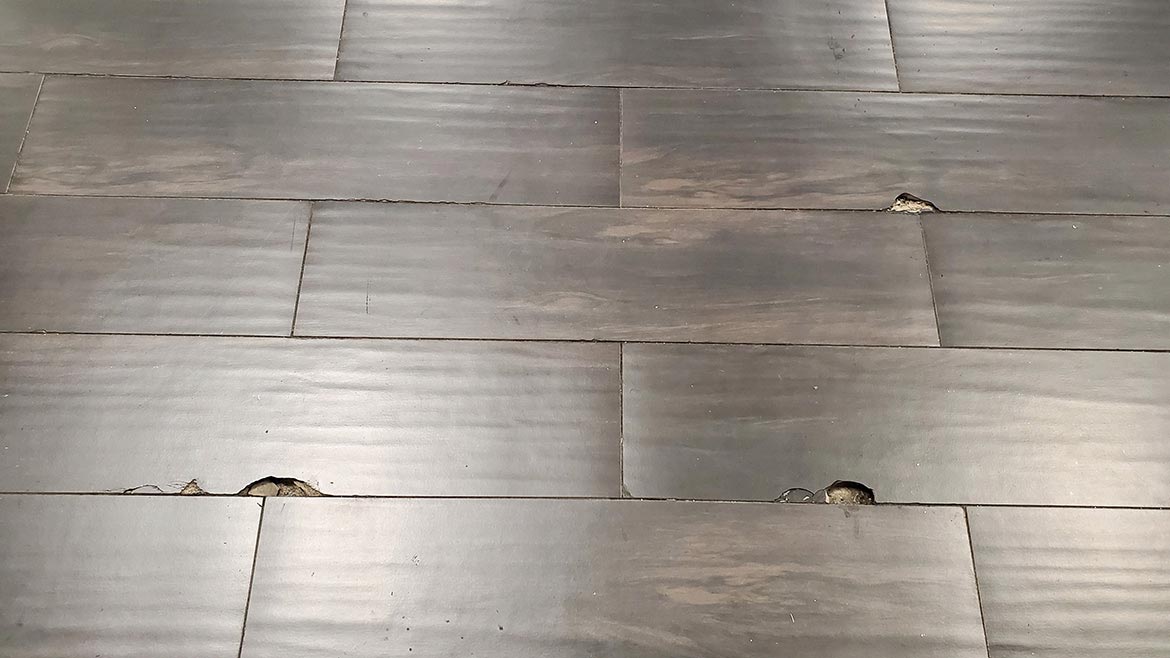Do You Know the ANSI Standards for Tile Coverage, Offset and Acceptable Lippage?

Photo: Getty Images.
An excellent quality tile installation will stand the test of time and remain a shining example of the beauty and durability of ceramic and porcelain tile; however, when other installations of lesser quality exist, the tile industry gets a black eye. The tile installation in the below image is an example of a whole host of installation failures that do not follow the American National Standards Institute (ANSI) requirements.
ANSI A108.5 – 2.2.2 Apply mortar with flat side of trowel keying in with pressure, over an area no greater than can be covered with tile before the mortar skins over. Cover surface uniformly with no bare spots and with sufficient mortar to ensure a minimum mortar thickness of 3/32 in. (2MM) between tile and backing after tile has been forcibly embedded. Tile shall not be applied to skinned-over mortar.
ANSI A108.5 – 2.2.3 Contact area shall not be less than 80%. Contact area on all exterior installations or interior wet installations shall not be less than 95%. The 80% or 95% coverage shall be sufficiently distributed to give full support of the tile with particular attention to all corners and edges of the tile. To achieve the 80% or 95% coverage required in the project specification, select a notched trowel sized to facilitate the proper coverage. It may be necessary to flat back trowel individual tile with bond coat to achieve the proper coverage. Embed the tile or tile assembly in the mortar by pushing in a direction perpendicular to the combed ridges to fully collapse them and achieve specified coverage.
ANSI A108.02 – 4.3.8.2 Running bond/brick joint and any offset pattern: For running bond/brick joint or any other offset patterns (i.e. non-continuous grout joints) utilizing tiles (square and/or rectangular) where the side being offset is greater than 15 in. (nominal dimension), only patterns with an offset of 33% or less shall be specified. If a pattern with an offset greater than 333% is desired, the specifier and owner must approve a mock-up and the resulting lippage.
ANSI A108.02 – 4.3.7 Lippage – guidelines, explanation, and caution: Lippage refers to differences in elevation between edges of adjacent tile modules.
The chart that accompanies the lippage section includes a list of the allowable lippage. For Pressed Floor and Porcelain Tile, all tile sizes, with a 1/16” to less than ¼" grout joint, the allowable lippage is 1/32” plus the allowable lippage of the tile as permitted in ANSI A137.1.
Given the tile industry standards and best practices that support the proper installation of tile, one would think and expect a stellar installation. Unfortunately, a lesser example catches the eye of the consumer causing them to doubt its integrity. Everyone in the tile industry needs to push the quality bar to the next level and beyond.

Ignoring the ANSI standards on mortar coverage, 33% offset, and allowable lippage yields a bad reflection on tile work. Photo: Scott Carothers.
Looking for a reprint of this article?
From high-res PDFs to custom plaques, order your copy today!







